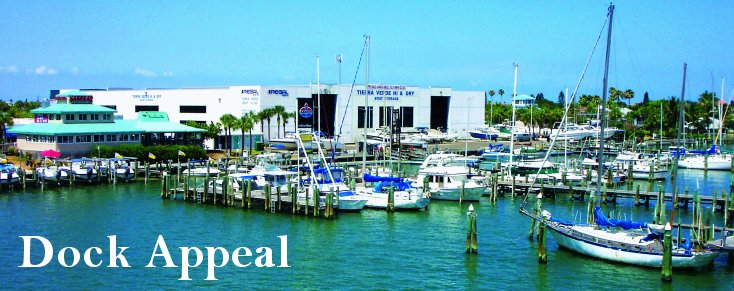By Mary Kelley Hoppe and Victoria Parsons
Bay Soundings 2004
It’s the waterfront equivalent of the Good Housekeeping Seal of Approval, and an increasing number of marinas are vying for it.
So far, 86 marinas have earned Florida’s Clean Marina designation; another 213 have requested assistance, and dozens of those are completing action plans.
While that’s a drop in the bucket in a state with more than 1800 marinas — more than twice as many as any other state — it’s significant nonetheless.
Marinas and boatyards — and the hundreds of thousands of boats they serve — can significantly impact water quality. Most impacts are cumulative, from countless small fuel spills to incident al oil leaks to heavy detergent s used to clean painted hulls laden with copper that flakes off and ends up in bottom sediments.
Enemy one is storm water runoff, which conveys oils, greases, heavy metals and degreasers from marina and boatyard service areas and parking lots into nearby streams and waterways. Newer facilities are required to treat stormwater, while older facilities, built before current environmental regulations were enacted, are exempt. That’s resulted in a mish-mash of environmental safeguards that run the gamut from none at all to retention ponds that hold and filter contaminants.
Fortunately, many marinas understand that a clean marina is good for business, and the state’s Clean Marina Program is capitalizing on that. “Boaters are looking
for dock appeal,” says Jan Delaney of the Florida Department of Environmental Protection, who manages the agency’s Clean Marina/Clean Vessels grants program.
“We’re creating an economic link between a marina’s operations and the environment,” adds Delaney. “We’re formalizing what boaters want.”
Begun in 1999, the voluntary program enlists marinas and boatyards to evaluate their operations, implement a series of environmental house- keeping measures and educate boaters on ways to minimize impacts.
“We couldn’t do this without the partnership of the marine industry,” says Delaney. The Marine Industries Association not only has been instrumental in developing and promoting the program, but they also provide free technical assistance to marinas. The designation process can take up to 18 months and begins when a facility attends a Clean Marina workshop where they receive a toolkit with videos and information on pollution prevention measures. Participants sign a pledge agreeing to conduct a self-review and complete an action plan within 90 days.
 “In the meantime, we make ourselves available for informal walk-throughs,” says Rose Poynor, FDEP’s point person for Clean Marinas on Tampa Bay, to help size up operations and advise owners on ways to improve them. Facilities are awarded points based on a checklist assessing their operations and practices from emergency their operations and practices from emergency marinas to be better environmental stewards.
“In the meantime, we make ourselves available for informal walk-throughs,” says Rose Poynor, FDEP’s point person for Clean Marinas on Tampa Bay, to help size up operations and advise owners on ways to improve them. Facilities are awarded points based on a checklist assessing their operations and practices from emergency their operations and practices from emergency marinas to be better environmental stewards.
A lot of it boils down to good housekeeping, says Poynor. “We recognize that there are costs involved but many of the actions are common sense practices,” like properly labeling and storing chemicals, cleaning boats with citrus cleaners instead of toxic chemicals, and using liners and drip pans in work areas and under portable gas containers to catch spills.
Good marinas go further, for instance, by stocking the alternative cleaners and environmentally sensitive products they recommend.
Based on a survey of 78 participating marinas, DEP estimates that clean marina recycling effort s alone have kept 5.6 million gallons of oil, 1 million gallons of antifreeze and 3.7 million pounds of aluminum out of the water. Many clean marinas also recycle fishing line and fish carcasses.
The number of sewage pumpout facilities statewide also has increased. Federal clean vessel funds have enabled the state to grant funding for 276 sewage pumpouts since 1995.
